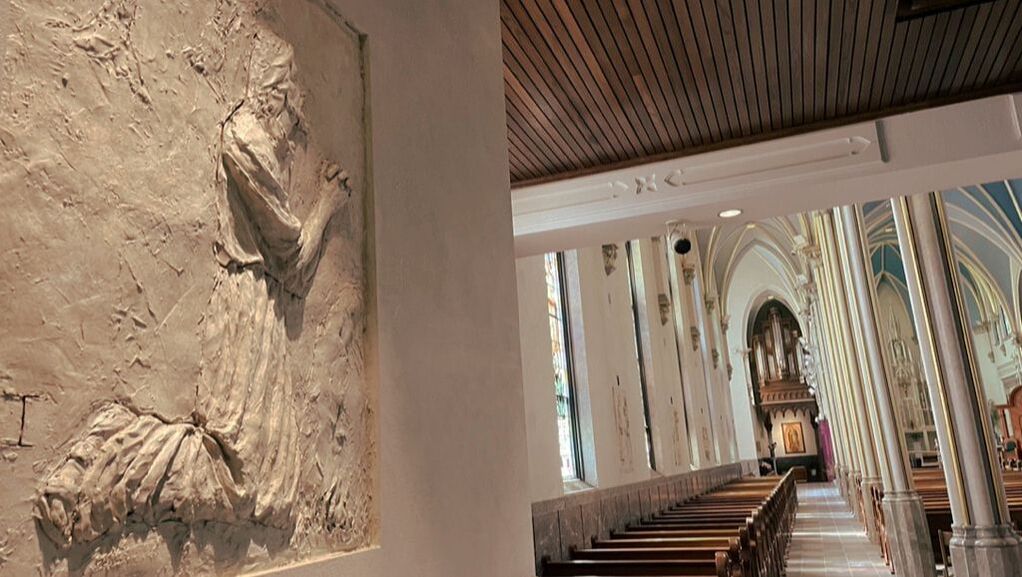“Learning to listen to divine silence is the crux of walking the stations. Church leaders through the centuries have encouraged and adapted this practice for the simple reason that it attunes a sojourner’s soul to the Word’s loving wordlessness." The Stations of the Cross: A Brief History
There is a tradition that Mary, mother of Jesus, revisited Jesus’ journey to the cross each day after his death in remembrance of him – an idea with which I can certainly resonate as a mother who has grieved. In the 300s, particular sites along this pathway in Jerusalem were officially marked, and there is record of large pilgrimages to them in the writings of St. Jerome (342-420). In the 400s, churches began to reproduce these holy sites in other locations so that pilgrims could engage with them devotionally without the necessity of travel. This practice continued over the centuries, and the term “station” began to be used for the stations in the 1400s by an English pilgrim to the Holy Land. Christians around the world continue to use the Stations of the Cross as a devotional practice today. The Scriptural Stations of the Cross A variety of versions of the Stations of the Cross have been used over the years to contemplate the events of Jesus’ death, consisting most commonly of fourteen stations in total. One version that is equally accessible to both Protestant and Catholic Christians is a sequence introduced by Pope John Paul II in 1991: the Scriptural Stations of the Cross. Grounded solely in the words of Scripture (without imaginative additions from tradition), the Scriptural Stations of the Cross begins with Jesus’ prayer in the garden and ends with his Crucifixion. It is these stations that I had an opportunity to contemplate during the first week of Lent, and I am excited to bring you my reflections as we journey together toward Easter. Mindfulness & God at the Stations Do you already have a practice of the Stations of the Cross during Lent? If so, you are unlikely to be surprised at the mindful nature of this practice. When we pause to use all our senses in engaging with Jesus’ walk to the cross, we have an opportunity to come fully into the moment and be present to whatever it is God has to say to us through that reflection. As in the practice of Lectio Divina, God uses our full presence with Scripture to fill our awareness with his full presence. Getting quiet helps us see and hear him with more openness and clarity. As I walked the path of the Stations of the Cross this year, I heard powerful messages from God’s heart to mine about suffering, rejection, connection, love, belonging, power, hope, and resurrection. Getting quiet at the stations with mindful attention to God allowed me to hear what God had been saying to me all along. He understands. He sees. He is unafraid. He has everything that I need and more, if I only stay connected to him. Ready to walk the path? If you haven’t already, I encourage you in this Lenten season to find (or create) a place nearby to pray the Stations of the Cross. Block out some time to journey that path with Jesus, listening with full mindful attention to what he has to say from his heart to yours. Bring a Bible with you, or a simple list of the Scriptures associated with each station, so that you can receive both the images before you and the words of Scripture. Easy access can be found using this Catholic version, or by using a Protestant version such as this one from the First Baptist Church of Asheville or this one from the Church of England. Be ready to get quiet, to slow down, and to listen for God’s voice. I promise that he’ll be speaking, even if it takes some time to hear. I also invite you to walk the path with me, as I take the remaining five weeks of Lent to blog brief reflections concerning my own experience of mindful, in-the-moment attention at the Stations of the Cross. I will pass on to you, in abbreviated form, what God whispered to me. He understands. He sees. He is unafraid. He has everything that you need and more, if you only stay connected to him. Come journey with me! The first reflection drops on Wednesday. P.S. The Stations I spent time with this week are located in the Cathedral of St. Andrew in Grand Rapids, MI, which is open to the public every day, and I’ll be referencing their images for each blog post. Carved by Michigan artist Suzanne Young, the sculptures line the walls of the cathedral and are breathtaking in their powerful simplicity. The photos I’ll be sharing don’t do them justice – so if you're able, come see them for yourself! You can find accompanying scripture and prayer for each station on the church’s website here.
4 Comments
3/15/2023 11:39:32 am
Thank you. I am eager to celebrate Lent differently this year with a contemplative mindset.
Reply
Irene
3/23/2023 08:29:24 am
Lent is rich with opportunity for spiritual contemplation, and I'm delighted to hear this is your approach to the season this year. Thank you for commenting, Laura!
Reply
Elizabeth Sadhu Farwell
3/19/2023 12:59:34 pm
I love this beautiful practice. Thanks for sharing.
Reply
Irene
3/23/2023 08:30:22 am
Thank you, Elizabeth!
Reply
Leave a Reply. |
Author
I am Irene Kraegel. I am licensed as a clinical psychologist and teach mindfulness on a faith-based university campus. I practice mindfulness because it opens me up to God (a.k.a. brings joy). I am writing here in hopes of sharing some of my experiences and thoughts related to the practice of mindfulness in the life of a Christian. Thanks for reading! Books
Blog archives
December 2023
|




